From the beginner rider still trying to master that perfect circle to the preliminary athlete sharpening up for their spring event season, clinician Sinead Halpin had exercises for everyone on the Day 1 of her two-day clinic at Antebellum Farm in Lexington, Ky., on April 16.
Private and group dressage lessons were followed by a day of gridwork and technical exercises, and Halpin’s advice (peppered with a good amount of humor and fun) was adapted to fit a myriad of horse and rider problems.
So gather round, and listen up! Here’s what Halpin has to say…
On the importance of those hated ground pole exercises…
“There are technical pole exercises all over my ring, because if I make a mistake or the horse makes a mistake, there’s not a catastrophic issue, because they’re poles. They’re just going to step on it.”
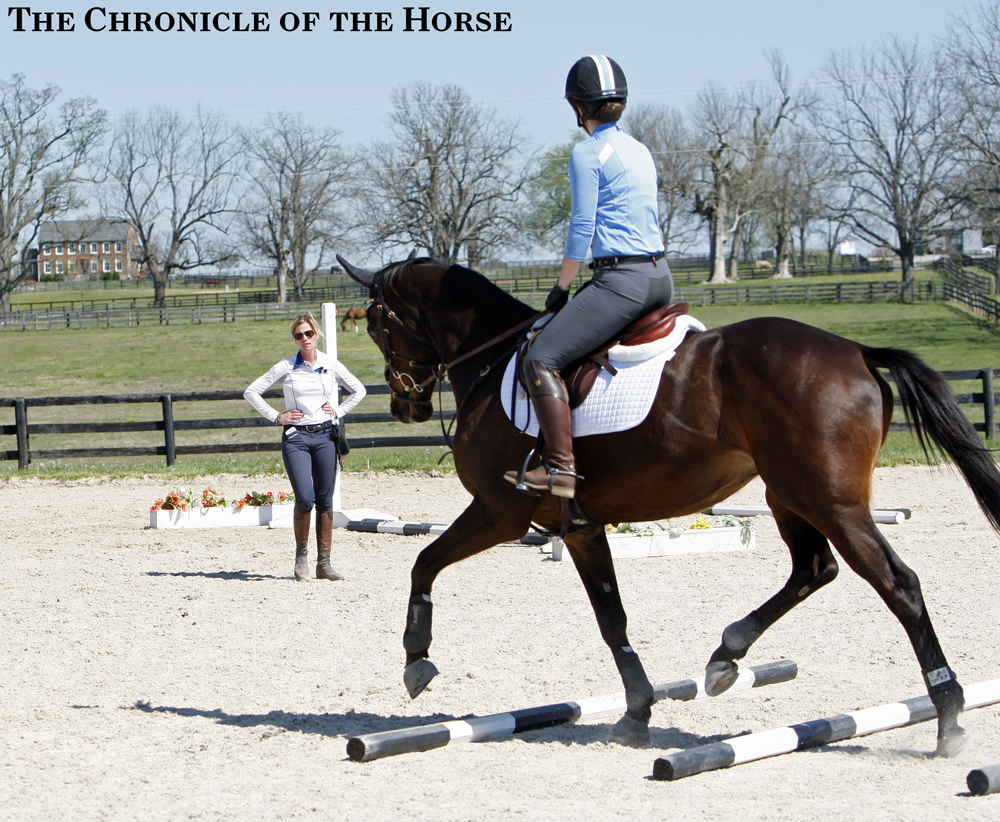
A rider in the training level group negotiates the trot poles as Halpin watches.
“I think from a rider confidence perspective, as a professional or an adult amateur or a kid, if you crash through an oxer or a crossrail or have a stop, it’s going to mess up whatever training you’re trying to do. When you’re learning and growing and trying to figure stuff out, you’re going to make mistakes.
On working with young or green horses…
“Often you get a young horse or a green horse in like this, and they see a jump and they just run to it. You might be saying ‘Whoa, whoa,’ but they don’t hear it, so you just have to keep increasing the volume until they do. That’s where you have to be a conscientious rider. On a 1 to 4 scale, you always want to start at a 1; you never want to start at a 4, unless you’re in a dangerous situation.
“But then if you keep going 1, 1, 1, 1, you’re teaching them to ignore you, so you have to keep turning it up. You need to recognize when you turn it up to 2 or 3, so that you notice OK, that’s the point I need to get to. I think with a lot of people, it’s either doing too much, or doing nothing at all, and nothing in between.”
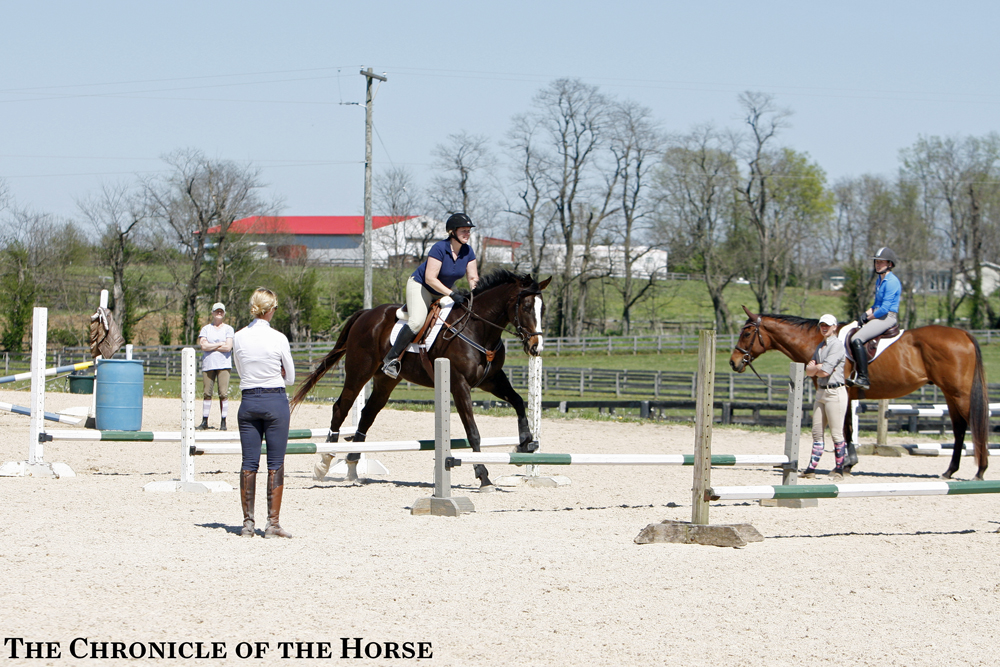
Heidi Turpin and Rally go through a gymnastics line as Halpin watches.
On riders with a knack for trying SO hard to find a distance they completely miss it…
“That’s when you have to keep putting in exercises where you have to think about the canter. The one girl that was doing it here, I just kept yelling at her ‘add a stride now,’ so it still actually had something to do with the distance, but she recognized what adding a stride meant, and I just had her do it in the moment.
“Because she was starting to stare for the distance way back here, that’s when I would say, ‘alright, you’re looking for the distance, add now.’ Then she would actually sit back and add for a second. That gave her the patience and then the distance showed up.
“It’s when you get back there and you’re staring at it that you lose the canter, so you have to be a little bit clever on how you work that in, but it’s all about the canter.”
“Bending lines are hard, man,” Halpin said with a laugh to the training rider group. Here’s what she meant by that…
“Bending lines are one of those things you have to practice, because when you first start doing bending lines they’re really difficult. Then once you figure out how to make them work to your advantage, you look forward to them because you actually have way more options in a bending line than you do in a straight line.
“In a bending line, you can carve out your track, so when [this rider] was first coming through she overcompensated the line. The second time she undercompensated it, and then the third time she got it right.
“So they’re one of those things where once you open that can of worms, you’ve got all of these options, and sometimes having no options is easier.”
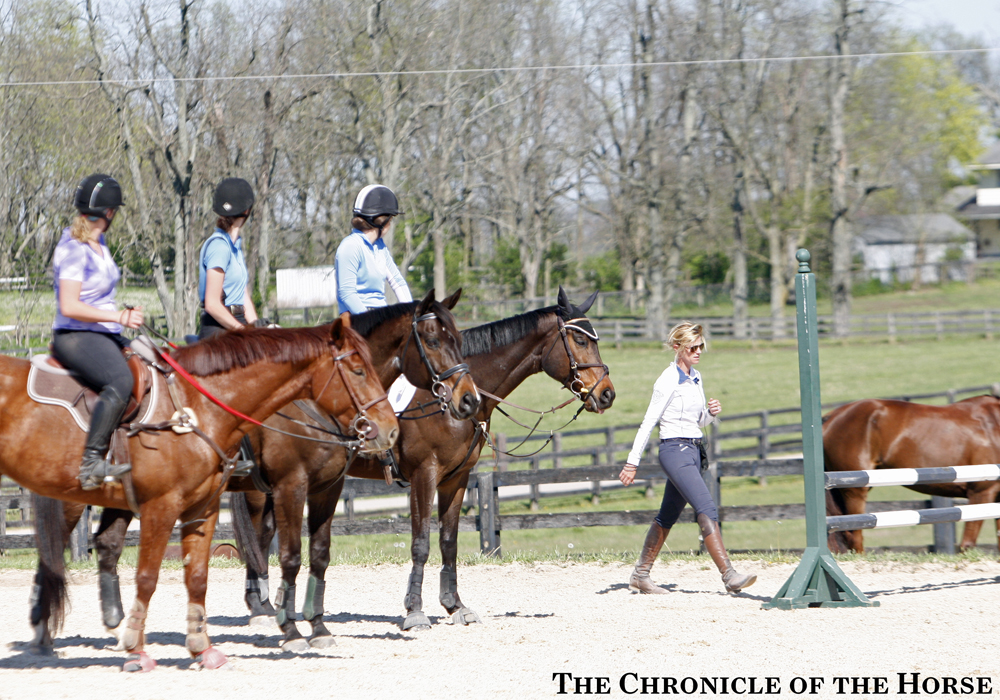
Halpin walking a line.
ADVERTISEMENT
“In a straight line, its just whoa or go, but bending lines you’ve got to calculate how you jump in and jumping in on your track or off of your track. It makes a difference in how the whole thing works. I think that’s where it gets complicated because bending lines you can plan them, but how you jump in really affects it.
“You have to adjust more. Once you start introducing bending lines things tend to go really wrong, and then they get really easy!”
Exercises for the hard mouthed horse, exercises for the featherlight horse…
Halpin had one rider with a particularly soft and light horse work on bringing the horse’s haunches in and raising her shoulders up, what she called an “outside to inside” exercise, versus an “inside to outside” exercise used to lighten up a hard mouthed horse.
“Her horse needs to be a little more engaged—she’s really light in the contact. You can’t get her to take the contact, so you were using more of a strength/weight-bearing exercise, to bring her outside to inside.
“Some horses get really locked in their jaw, and really locked through their whole body, and often at that point you want to do an inside to outside, almost disengaging or suppling exercise, to break their body up. With her horse we’re actually trying to get her connected and work a little better.”
Get that cross-country energetic feeling in the dressage ring…
“When you’re coming to a fence, normally a horse is interested in that fence, reading that fence, and they’re backing off. Their balance comes up, and then you don’t have to create something to balance, because the gallop has done the footwork, and the jump sets them back.
“Whereas sometimes in the dressage, and even in the show jumping, you have to create a little bit of footwork to balance. In here we’ve got to motivate the footwork to balance. That’s why I was telling her to go out and gallop and get that feeling; that’s what you want in here.”
For the sweet schoolmaster looking to spruce things up in the show ring…
“If you have a horse that’s got a nice rhythmical working gait, the only way to add any type of quality is to work on both sides of that—the collected step and the forward step, the carry and the push, the carry and the push.
“That horse is really, really sweet, and so the rider was working through all the movements all the time, just managing the working gait, so there was never any inspiration to the work for the horse.”
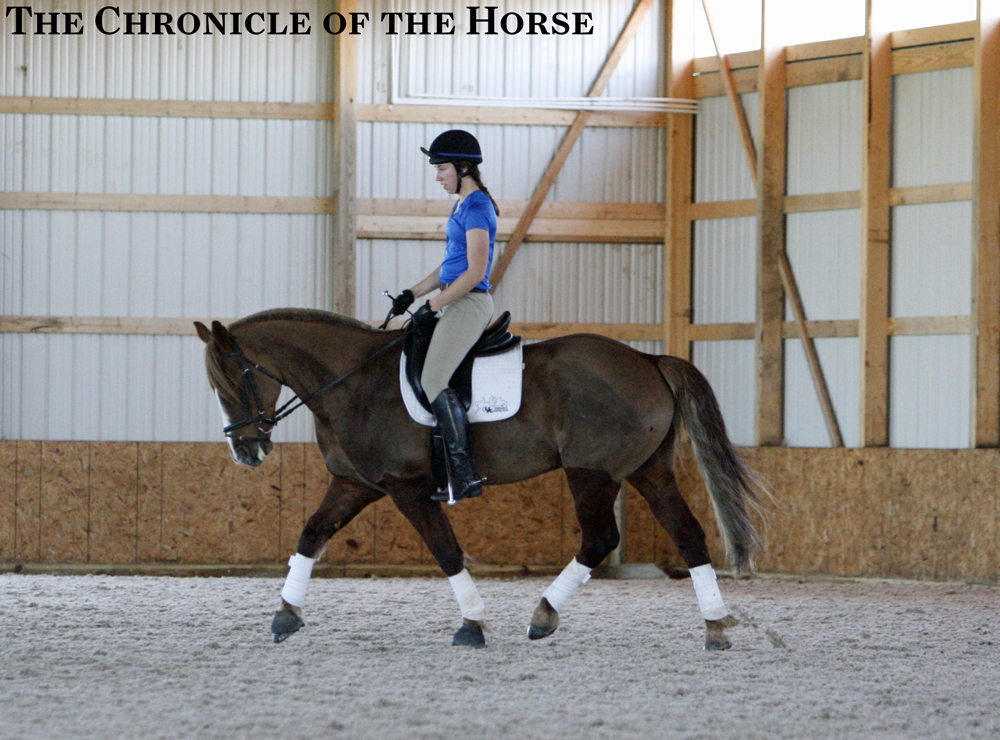
Erika Berntsen worked on improving Finnigan’s gaits.
“That was what we were trying to do—that she’s managing and working hard in the collected work and the forward work but the working gait is something that the horse is responsible for.
“It’s like ‘Wow, I just had to carry myself for a little bit and then I had to go for a little bit, and now I’m going to take that and put some presence in to the actual working gait.’ I think that happens a lot with horses who have really great attitudes, because you can kind of manage everything.”
There’s a lot to do at the walk…
One rider’s 45-minute dressage session was spent almost exclusively at the walk. Halpin explained the value of walk work for a horse locked in its hip or shoulder.
“That horse is quite stuck in its shoulder, and its hind end, so compounded with speed, it makes it difficult to break up the actual movement of the feet. So what we were trying at the walk is to really establish for the rider that actual exercise of moving the shoulder separately from moving the hind end, so there was a hind end yield and then a shoulder yield.”
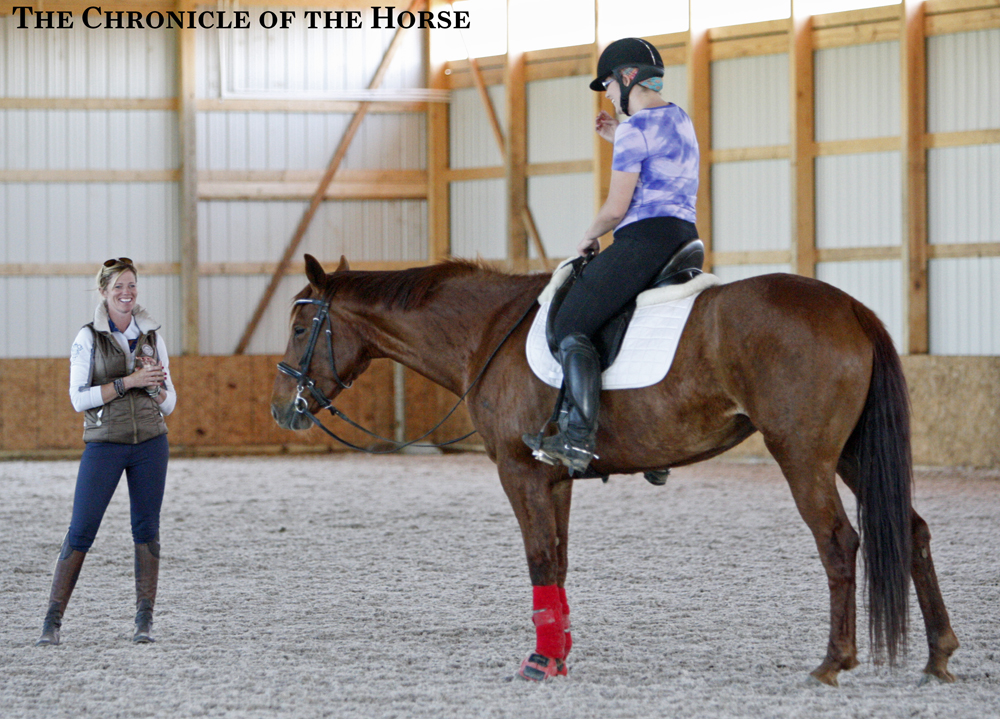
Daina Kaugars and Re D’Feined spent much of their flat session at the walk, working to enhance their connection.
“I was trying to get her comfortable enough that she could teach it to the horse, and then the horse comfortable enough with the exercise that we could add a little speed with the trot and the canter. So she got real comfortable with the walk with everything before we brought it back up.
ADVERTISEMENT
“I don’t think it’s even because she’s a chestnut or because she’s a mare, though that can often be the case. Just the way she is built, she was kind of stuck everywhere, she had a lot going on. I think when you’re teaching a horse and a person you have to do it slowly.”
Want to set up the same jumping exercise Halpin had at this clinic in your ring?
Here’s how to set your fences, and what exercises Halpin had her riders do.
The whole ring was essentially a figure-eight pattern, with the middle of the pattern being the three bounces set at 9’ apart. Jumps were substituted out for poles depending on the level of the clinic group.
Halpin started by having riders navigate only sections of the figure-eight pattern, breaking it into big S-shaped, for example going from the ground pole-jump to the bounces to the oxer.
Occasionally Halpin would have riders circle in the middle of their figure-eight pattern to reorganize and collect before carrying on.
Quotable Halpin moments:
(To a student with a fussy horse) “You tell him, ‘You mess around down there, I’ve got to steer the boat.’ Stay above it all.”
“It’s a hamster wheel of energy—it starts in the hind end and the back and comes through the reins and gets recycled.”
“We want to create smart, thoughtful horses, so when they come to something spooky we can drop the reins, support them with our leg and say, ‘Figure it out.’ “
“These [pole excercises] are not power excercises. These are to create a calm, training brain. We’re doing dressage over poles.”
“You’re trying to be so quiet and still, because he’s a hot horse and you’re just trying to keep a lid on it. Insetad of trying to be quiet and still, think ‘I have to ride well, and I have to be able to put my leg on and ride him.'”
(To a student with an older horse) “Sit down on him. I like that off-the-back light seat, but he wants to run away with you, he doesn’t get that luxury yet. Maybe when he’s 25!”
“You want to change the speed, they fishtail. You want to change direction, they want to speed. So you have to be of two minds when they’re like that, you have to monitor that.”
Check out Day 2 coverage of the clinic, “Move Your Feet: The Cast Of Characters At Day 2 Of Sinead Halpin’s Clinic.”
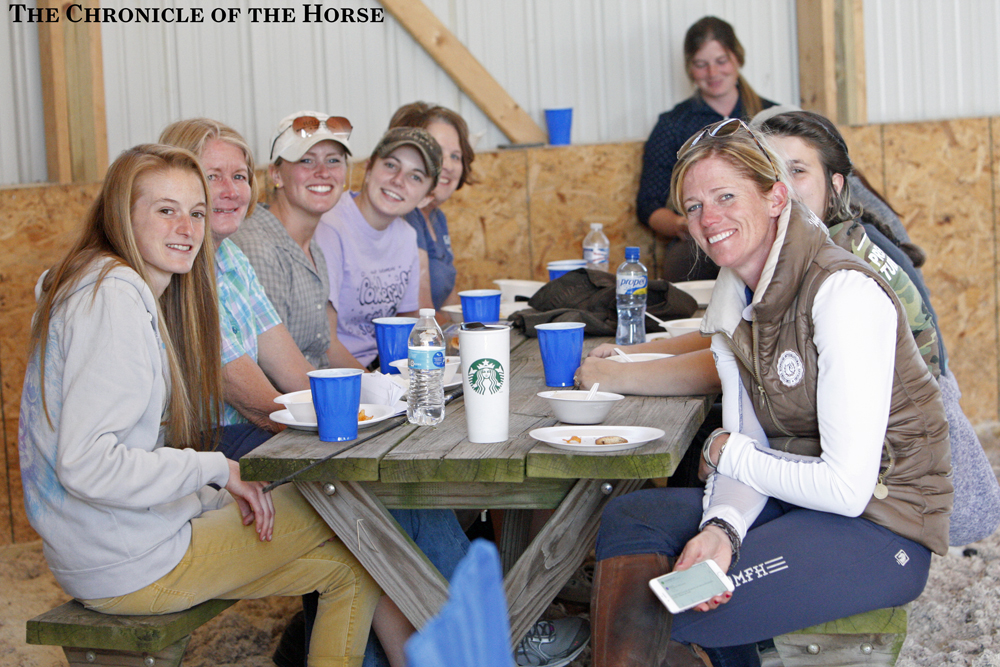
Sinead Halpin (front, right) shared lunch and conversation with the clinic attendees.
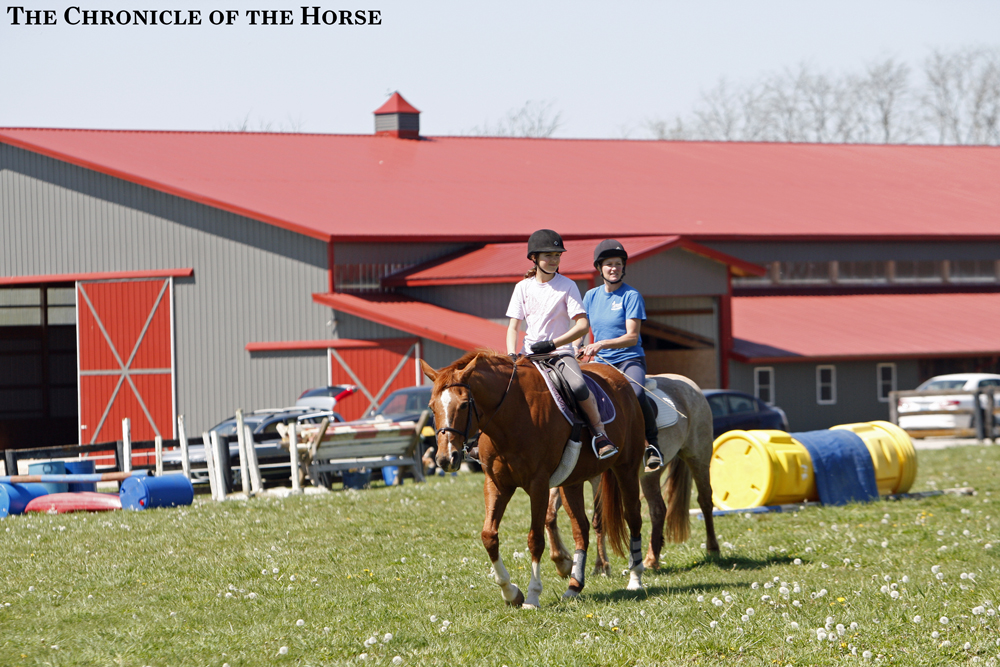
The clinic took place at Antebellum Farm in Lexington, Ky., and curious boarders hacked by as the Sinead Halpin clinic went on.
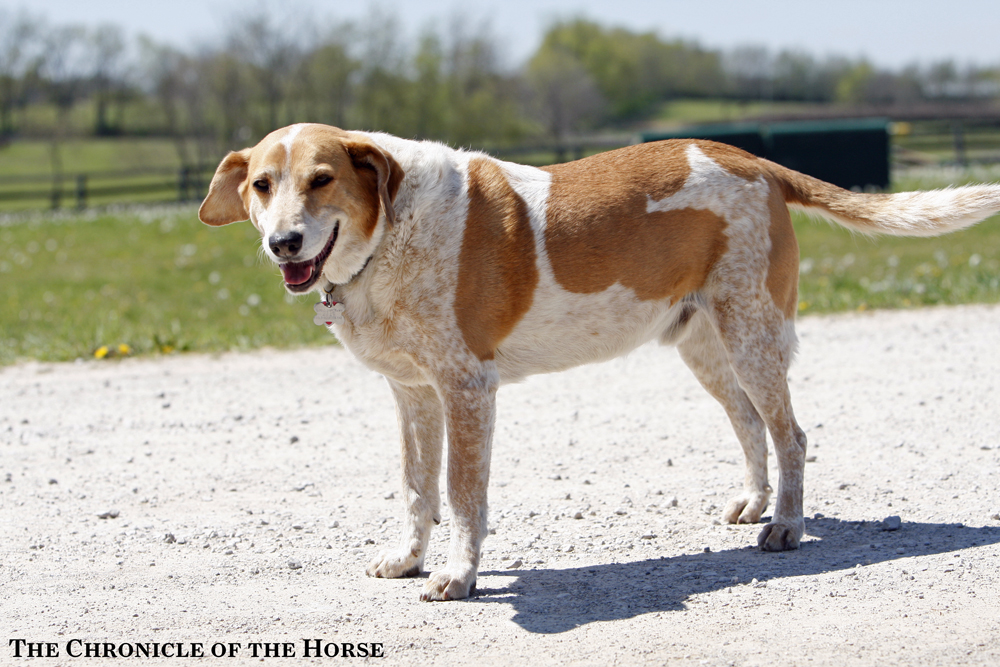
Peanut, the Chronicle’s able photo assistant for the day.















